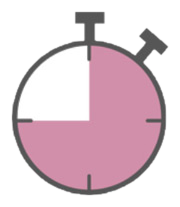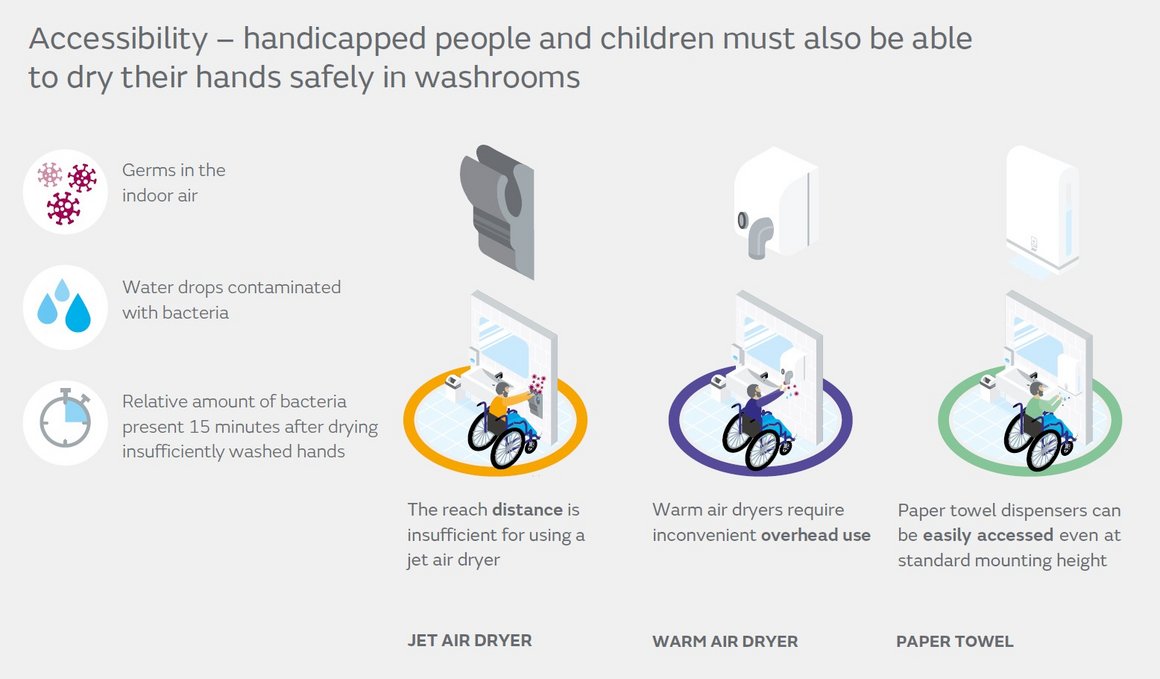
Science decides
Hand hygiene is an important part of our everyday life. However, it took a crisis to make even more people aware of the importance of washroom hygiene and the effects of a lack of attention to hand hygiene.
We are aware of our responsibility as one of the largest European manufacturers of hygiene products and the respective dispenser systems. We would like to share our knowledge and many useful tips on this current topic with you. So that together we can successfully bring professional hand hygiene into Europe's washrooms.
1.
RESIDUAL MOISTURE
Too much residual moisture on the skin
2.
SURFACE HYGIENE
Transmission of germs through contact with frequently touched surfaces
3.
AIR HYGIENE
Transmission of germs through germ-containing water droplets (aerosol)
4.
NOISE AND ACCESSIBILITY
Poor accessibility of the hand drying devices
Residual moisture on the skin can lead to skin damage or promote the growth and transmission of germs
Studies show that the average time a washroom visitor spends drying their hands is only around 10 seconds1
The first and most important pillar of hand drying is the removal of residual moisture on the skin, because such moisture can lead to skin damage and promote the growth and transmission of germs. Studies show that the average time a washroom visitor spends drying their hands is only about 10 seconds1. It is therefore crucial that as much moisture as possible is removed from the skin within this short time.
The second pillar of hand drying is surface hygiene. All washrooms have numerous surfaces that are often heavily contaminated with germs – however, these are not only the handle of the washroom door or the area of the door leaf around the handle. According to studies, this also includes the floor, soap dispensers, taps and the housing of airflow dryers3,4. Touching surfaces contaminated with germs after washing hands impairs the effect of washing. Therefore, when visiting a washroom, touch as few surfaces as possible: this reduces the risk of further spreading existing germs. This also includes unintentional touching. Especially with jet hand dryers into which the hands are inserted, it occurs up to 13 times per use, as shown by a study from the USA5.
This is particularly problematic, because over 1,000 times more germs have been detected on jet hand dryers than on paper towel dispensers6. Paper towels, on the other hand, help to minimise risk – even with manual dispensers the paper is only removed from the bottom of the dispenser housing, which significantly reduces the risk of accidental contact. Paper towels can also be used for turning off the tap or operating the door handle, so that the risk of germ transmission is reduced here as well.
Click here for our towel dispensers
Satino by WEPA Towel dispensers
The third pillar is air hygiene. Two well-researched germ-spreaders are found in washrooms that release large quantities of germs into the indoor air. One is the toilet flush – when flushing, the toilet lid should always be closed to minimise the risk of infection via aerosols. The other germ-spreaders are electric airflow dryers: when actuated, these powerfully distribute germ containing air via aerosol in the room3,7,8. Even directly after washing your hands, these are not completely free of germs. In addition to the bacteria in our skin flora, lingering viruses can, if hands are not washed properly, also enter the indoor air via airflow dryers. Since even just a few germs are sufficient for infection with many viral cold- or diarrhoea pathogens, and because viruses remain in the indoor air in an aerosol for several hours, a risk of infection can also arise in this way9.
Many germs could be detected after deposition on horizontal surfaces in the immediate vicinity of airflow dryers (e.g. on the floor). The highest proportion of germs was found in the immediate vicinity (in approx. 1 m radius) of the airflow dryer9. In contrast to various electric fan dryers, which generate a germ-containing aerosol with high air speeds, this danger does not exist when drying hands with paper towels. Therefore, paper towels are also the better choice from the point of view of air hygiene. Paper towels produce almost no aerosol containing germs, even when drying poorly washed hands10,11.
The fourth pillar is user-friendliness. The high air velocity of air flow dryers is achieved by very high engine speeds, which lead to very high noise levels. According to studies, these devices can reach a volume of 94 dB. In addition to the spread of germs from such devices, this volume is also a reason why, according to the Robert Koch Institute, jet air dryers should not be used in medical facilities10. Due to their smaller size, children or people in wheelchairs have their heads closer to the jet air dryer, resulting in even higher noise levels of up to 115 dB11. The Federal Environment Agency also comes to the conclusion that these dryers pose a medium hearing hazard for children12.
Die vierte Säule ist die Anwenderfreundlichkeit. Die hohen Luftgeschwindigkeiten von Luftstromtrocknern werden durch sehr hohe Motordrehzahlen erreicht, welche zu sehr großen Lautstärken führen. Studien zufolge können diese Geräte eine Lautstärke von 94 dB erreichen. Neben der Keimverbreitung solcher Geräte ist auch diese Lautstärke ein Grund, weshalb die Jet-Lufttrockner laut Robert Koch-Institut nicht in medizinischen Einrichtungen eingesetzt werden sollten10. Aufgrund ihrer geringeren Größe sind die Köpfe von Kindern oder Menschen, welche auf einen Rollstuhl angewiesen sind, näher am Jet-Lufttrockner, was sogar zu noch höheren Geräuschpegeln von bis zu 115 dB führt11. So kommt auch das Umweltbundesamt zu dem Ergebnis, dass diese Trockner für Kinder eine mittlere Gehörgefährdung darstellen 12.
115 dB is the noise level that jet air dryers can reach11
In addition to the low volume during use, paper towels also offer very good accessibility. They do not require constant overhead handling, as with airflow dryers or cotton roll dispensers, and dangerous leaning out of the wheelchair, e.g. to operate an air flow dryer, in which the hands have to be put in from above, is eliminated.
Our concept for perfect hand hygiene!
Now is the time to make sure that the washrooms meet the latest hygiene standards. Satino by WEPA offers you the opportunity to expand your product range and meet the needs of your customers. We offer you a product portfolio that inspires in detail as well as in the overall picture and impresses with its touchless dispenser systems, especially in times of highest demands on professional hand hygiene.
With Satino by WEPA, attributes such as functionality, comfort and of course highest quality automatically become part of the equipment of every washroom room.
Sources & links
Suen, L. K. P., Lung, V. Y. T., Boost, M. v., Au-Yeung, C. H. & Siu, G. K. H. Microbiological evaluation of different hand drying methods for removing bacteria from washed hands. Scientific Reports 2019 9:1 9, 1–7 (2019).
Patrick, D. R., Findon, G. & Miller, T. E. Residual moisture determines the level of touch-contactassociated bacterial transfer following hand washing. Epidemiol Infect 119, 319–325 (1997).
Best, E. et al. Environmental contamination by bacteria in hospital washrooms according to hand-drying method: a multi-centre study. J Hosp Infect 100, 469–475 (2018).
Suen, L. K. P. et al. The public washroom - friend or foe? An observational study of washroom cleanliness combined with microbiological investigation of hand hygiene facilities. Antimicrob Resist Infect Control 8, (2019).
European Tissue Symposium. Einmal mehr wurde bewiesen, dass Papierhandtücher im Vergleich zu Jet-Lufttrocknern die hygienischste Option für Waschräume sind.
Eurofins-Inlab Study - European Tissue Symposium. https://europeantissue.com/hygiene/studies/eurofins-inlab-study/
Margas, E., Maguire, E., Berland, C. R., Welander, F. & Holah, J. T. Assessment of the environmental microbiological cross contamination following hand drying with paper hand towels or an air blade dryer. J Appl Microbiol 115, 572–582 (2013).
Boles, C., Brown, G. & Nonnenmann, M. Determination of murine norovirus aerosol concentration during toilet flushing. Sci Rep 11, 23558 (2021).
Zemouri, C., de Soet, H., Crielaard, W. & Laheij, A. A scoping review on bio-aerosols in healthcare and the dental environment. PLoS One 12, (2017).
Robert-Koch-Institut. Händehygiene in Einrichtungen des Gesundheitswesens. Empfehlungen der Kommission für Krankenhaushygiene und Infektionsprävention (KRINKO) beim Robert Koch-Institut (RKI). doi:10.1007/s00103-016-2416-6.
Keegan, N. L. Children who say hand dryers ‘hurt my ears’ are correct: A real-world study examining the loudness of automated hand dryers in public places. Paediatr Child Health 25, 216–221 (2020).
Händetrocknung | Umweltbundesamt. https://www.umweltbundesamt.de/haendetrocknung-0







